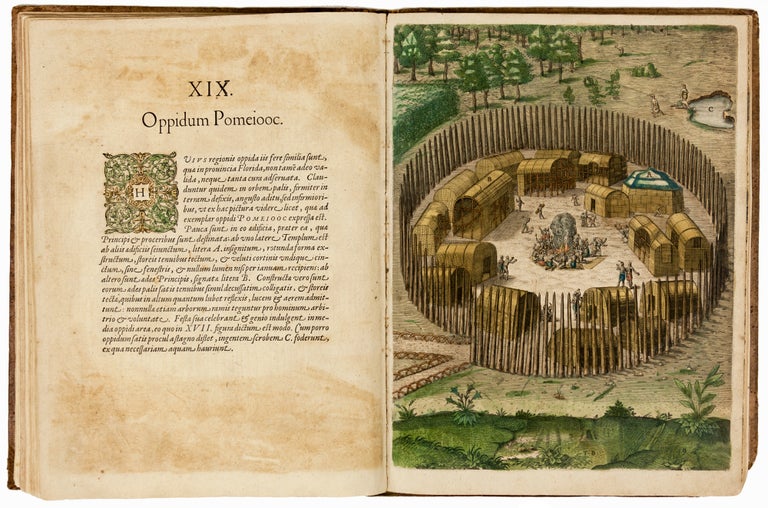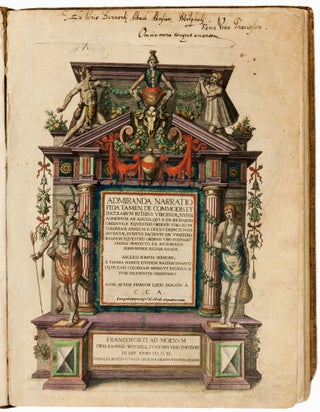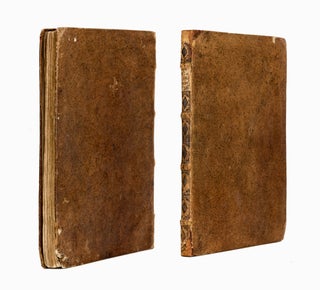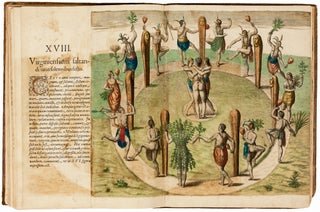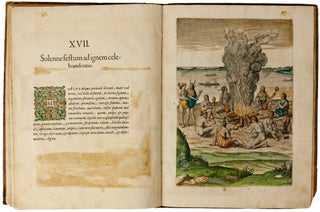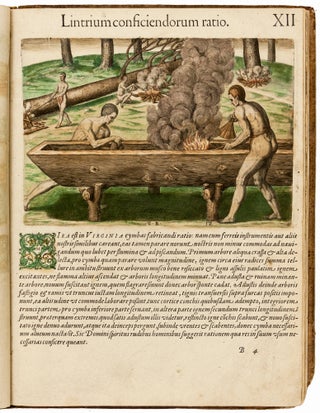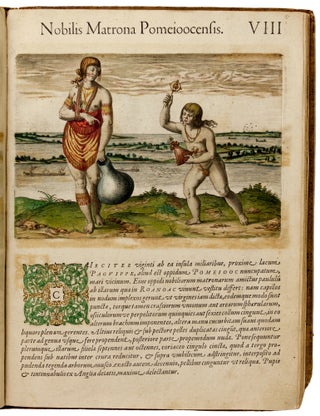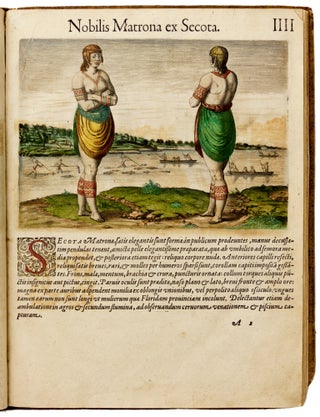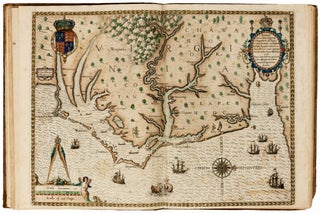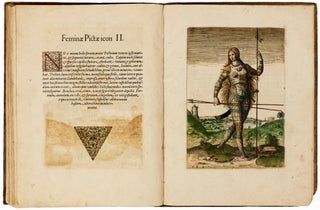Admiranda narratio fida tamen, de commodis et incolarum ritibus Virginiae.
Folio (315 x 237 mm). Engraved title-page, privilege statement on pasted-in slip, dedication to Maximilian I of Bavaria with his large engraved arms, double-page map of Virginia by Theodor de Bry after John White, 28 numbered engravings, ENGRAVED TITLE AND ENGRAVINGS FINELY COLORED BY A CONTEMPORARY HAND, of which 17 half-page with letterpress text, the remainder full-page or larger, nos. 2-23 by G. Veen or T. de Bry after John White, the last 5 by and after T. de Bry; no. 1 showing Adam and Eve (by T. de Bry after T. de Winghe), no. 2 a birds-eye view of the area around Roanoke island showing the arrival of the English, nos. 3-23 depicting scenes of native Virginian life, and nos. 24-28 showing the ancient Picts. Woodcut head- and tail-piece ornaments and initials, most lightly hand-colored. Blank leaf D6 present. (Section of title-leaf torn away with loss to lower outer section of engraving, the map with short fold break at gutter, slight restored break along guard, and a small tear into image, some offsetting or show-through of coloring, 2 or 3 text leaves browned, occasional marginal soiling, engravings 13, 18, 20 and 22 slightly cropped, 18 and 20 with minor short tears along guards, descriptive text to engraving 13 also cropped, small dampstain to upper gutter margins of a few leaves, printing flaw to plate section title affecting a few words in bottom paragraph.) 17th-century German speckled sheep over pasteboard, spine tooled in blind (restorations to head and tail of spine, a corner of back cover and a few small spots of leather worn or gnawed away). First Latin edition, first issue of Part I of Theodor de Bry's great collection of voyages, “the rarest volume of that series” (Sabin 30377), with fine contemporary hand-color. The text consists of a Latin translation of Thomas Hariot’s A brief and true report of the new found land of Virginia (London, 1588), an account of his participation in the second Roanoke expedition in 1585; only six copies of this English edition are known. The extraordinary engravings were based on White's famous series of watercolor paintings of Indian life, now in the British Museum. The double-page map of the Virginia coast and Carolina capes, engraved after John White, is regarded as “one of the most significant cartographical milestones in colonial North American history, [and] the most accurate map drawn in the sixteenth century of any part of that continent” (Burden 76). Thomas Hariot, explorer and scientist, was the first English compiler of information relating to the New World. After graduating from Oxford around 1580, Hariot’s interests turned to the exploration of the New World. In the early 1580s, Hariot tutored Sir Walter Raleigh and his sea captains in mathematics and navigation, and he participated in the initial planning of Raleigh’s first Roanoke expedition in 1583. After learning basic Algonquian from two Native Americans brought back from an expedition to Roanoke Island in 1584, Hariot was ready to venture out: he joined Sir Richard Grenville’s expedition, which dropped anchor in Roanoke in June 1585. Hariot and John White, the expedition artist, explored and mapped the area around Roanoke, carrying out Raleigh’s charge that they generate a textual and visual record of the settlement, its exotic flora and fauna, and the appearance, character, and daily lives of the local inhabitants. Hariot’s account and White’s watercolors presented the New World as simultaneously exotic and reassuring to English readers, an ideal site for continued efforts at colonization despite present challenges. In 1586, Hariot and White and their fellow colonists abandoned the Roanoke settlement and returned to England. Hariot lent his navigational expertise to helping the English defeat the Spanish Armada in 1588, and in the same year he published A briefe and true report of the new found land of Virginia. The small volume, devoid of illustrations, failed to attracted much notice, but it gained a much broader readership the following year, when it appeared in the first edition of Richard Hakluyt’s The Principall Navigations, Voiages and Discoveries of the English Nation. Then, in 1590, the Flemish printer Theodor de Bry included both Hariot’s text and White’s watercolors—transformed by de Bry into copperplate engravings—in the first edition of his own collection, the Grands Voyages. Published in English, French, German, and Latin, de Bry’s Voyages went through seventeen editions between 1590 and 1620. Elaborate copies were often commissioned by wealthy patrons, who valued books and their engravings as sources of information and as objects of curiosity and fascination. “De Bry’s engravings are the most important and accurate illustrations of North Americans published in the century after Columbus. His plates…introduced a generation of Europeans to the people of America, and in his comparison of Virginians to Picts foreshadowed the development of modern anthropology. Artists and engravers cribbed freely from his illustrations throughout the seventeenth and early eighteenth centuries, often using them inappropriately to represent Native Americans from different regions and widely divergent cultures” (Reese & Miles). In the early 1600s, Hariot served a brief sentence in the Tower of London for his role in a feud between Raleigh and the court of King James. By the mid-1600s, Hariot returned to his mathematical and astronomical interests, which he pursued until his death in England in 1621. John White returned in 1587 and became governor of the second colony there. Forced to return to England for supplies, White was delayed by the war with Spain, and when he finally returned to Virginia in 1590, the colony had vanished. Little is known of White’s life after the failure of the Roanoke Colony. The last surviving document related to White is a letter he wrote from Ireland in 1593 to the publisher of the prints of his Roanoke watercolors. Alden & Landis 590/31; Church 140; JCB (3) I, pp. 383-384; cf. Reese & Miles, Creating America (1992), 81; Sabin 8784 and 30377. Provenance: Bernard Albach of St. Ahaus, Westphalia (contemporary ownership inscription with mottos); June ?1628 ownership inscription; Nordkirchen (bookplate); Christie’s, Fine Printed Books and Literary Manuscripts --12/10/1999.
PRICE UPON REQUEST

